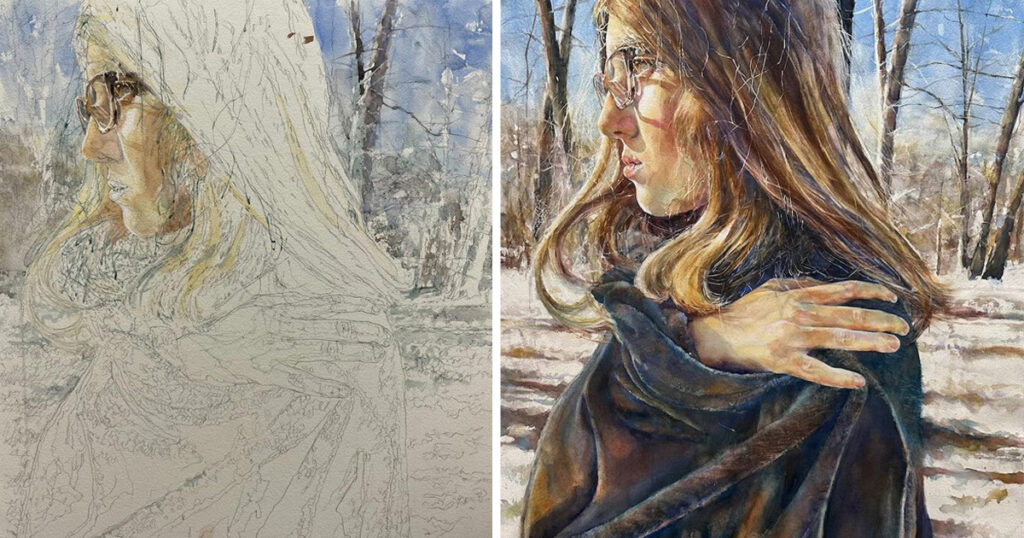Paint a Crystal Vase | Step-by-Step from Soon Warren

Splendor in the Glass
The keys to painting cut crystal in watercolor are a detailed drawing, masking fluid and patient glazing.
By Soon Y. Warren


Portraying cut crystal looks complicated and difficult at first glance. Creating a painting that has such detail requires both patience and time; however, when you start to break down the large shapes and define each element with light and dark, eventually you’ll define the overall shape and convey the transparency of the glass.
In order to show the sparkle of glass, preserve the white of the paper for the highlights using masking fluid. The surrounding colors within the composition define the shadow and color of the glass.

1. Draw the Outline
Define the details of the cut crystal and the shape of the glass. This is a time-consuming process, but it will be very helpful for later steps. Find the large patterns first, working toward the smaller patterns.

2. Apply Mask and Light Wash
Use the tip of a plastic brush handle (cut at a slant) to apply masking fluid on what will be the highlights of the glass. After the masking fluid dries, wet the surface of the paper. Next, using a 3½-inch hake, apply a very light wash of Prussian blue on the glass for the first of many layers of different colors. This light wash will become the light-to-midtone value of the glass.

3. Glaze Section by Section
Squeeze Prussian blue on your palette, a few inches away from permanent magenta. Apply a uniform mixture of the two to part of the glass, using a No. 12 round. As you move to other parts of the glass, adjust the color by varying the amount of each hue in the mixture. The masking fluid allows you to apply the colors freely and quickly. Let the paint dry.

4. Add a Glaze of Yellow
Apply diluted aureolin with a No. 12 round. The bluish and purplish colors of the glass will take on a mellow, earthy appearance after the application of yellow.

5. Add a Darker Glaze
Using a No. 8 round, glaze Prussian blue, aureolin and Hooker’s green section by section on the glass, alternating the colors. Because of the mask, you can still easily apply color without worrying about saving the white of the paper.

6. Remove the Masking
Remove the dried masking with a rubber cement pickup. Run a dry palm across the area to feel for sticky spots, which indicate that masking still remains on the paper. Rub off these last bits of dried masking fluid. Note that at this point, the unmasked whites stand out too much.

7. Fine-Tune the Details
Using the colors from previous steps, mix in permanent alizarin crimson as needed to deepen the color, and finish the glass with a No. 4 round. To render the reflections of stems and leaves on the glass, concentrate on darkening the areas in the center of the glass with dark bluish green. Create gradation within some areas of the crystal, especially in the center, to show the refraction of light. Tame most of the unmasked white lines with their surrounding colors, leaving only flickering white highlights. Tone down some highlights by glazing and others by using a brush to draw lines that follow the cuts in the glass.

Fill the Bowl
To finish the painting Roses and Crystal, I added a bouquet. Always keep in mind that the colors reflected by crystal depend upon the colors that surround or fill the crystal.
Masking Fluid Tips
- Different companies call masking fluid by different names. For example, Grumbacher calls it Miskit; Winsor & Newton calls it Colourless Art Masking Fluid; Grafix uses the name Incredible White Mask.
- Don’t use your good brushes to apply masking fluid; it will dry on the brush and won’t come off. Instead, use the tip of a brush handle or try toothpicks.
- Apply and remove masking fluid only after the paper has completely dried. Use rubber cement pickup to remove dried masking. Run a freshly washed hand over the painting to feel for any spots you may have missed, since they are not easily visible. Leftover dried masking will feel sticky to the touch.
Award-winning painter Soon Y. Warren (www.soonwarren.com) teaches workshops in watercolor throughout the United States.
This article is an excerpt from her book Painting Vibrant Watercolors: Discover the Magic of Light, Color and Contrast, copyright © 2009, and is used with the permission of North Light Books, an imprint of F+W Media Inc. Visit www.northlightshop.com or call 800/258-0929 to obtain a copy.
Free artistsnetwork.tv preview
Click here to watch a free video preview of Beautiful Botanicals With Bente Starcke King.
MORE RESOURCES FOR ARTISTS
• Watch art workshops on demand at ArtistsNetwork.TV
• Online seminars for fine artists
• Instantly download fine art magazines, books, videos & more
• Sign up for your Artist’s Network email newsletter & receive a FREE ebook





Have a technical question?
Contact UsJoin the Conversation!